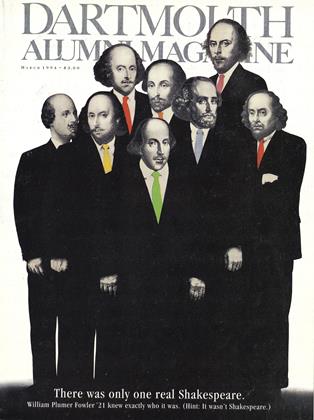One can never doubt the eternal and hoary nature of Dartmouth tradition. So who would have thought that the essential core of Dartmouth Trips has only been danced at Moosilauke for 20 years?
Mary Heller Osgood '76 remembers showing up at the Ravine Lodge with the myriad of other trippees ready to dance and hear scary stories, just as freshmen do now. Legendary caller Everett Blake called his dances but then played one record, the "Salty Dog Rag," which no one knew how to dance to, "so they just wiggled," says
Osgood. But she knew this dance well and happened to find a partner
with a hazy knowledge. Mary came from the Putney School in Vermont, where the Salty Dog Dance—a southern step—had been danced frequently. The crowds caught on.
The next fall Osgood led a trip and helped at the Lodge. One day she taught the crew the Salty Dog Rag, so, as she says, "I could have somebody to dance with that night." The dance was a hit.
Crew members taught the freshmen, the freshmen came back to teach other freshmen, and the rest is history.
This Artist Played Hardball Next to eighteenth-century English caricaturist Jame Gillray modern politial cartoonists look downright deferential. This work, "The Twin Stars of Castor arid Pollux," was one of 26 hand-colored prints on display at Dartmouth's Hood Museum of Art over the winter. The piece Lampoons two well-fed left-wing members of Parliament-and ridicules and royalist traditions. Gillray made the print while under hire by a member of the goverment of william Pitt, whom Gillray previously had portrayed as "a Toadstool upon a Dung-hill."
 View Full Issue
View Full Issue
More From This Issue
-
 Cover Story
Cover StoryNO HOLDS BARD
March 1994 By Robert Sullivan '75 -
 Feature
FeatureCan Gerstner Make the Elephant Dance?
March 1994 By Woody Klein '51 -
 Class Notes
Class Notes1980
March 1994 By Daniel Zenkel -
 Article
ArticleDr. Wheelock's Journal
March 1994 By "E. Wheelock" -
 Class Notes
Class Notes1975
March 1994 By W. Blake Winchell -
 Class Notes
Class Notes1993
March 1994 By Christopher K. Onken
Article
-
 Article
ArticlePRESIDENT HOPKINS ATTENDS INAUGURATION AT AMHERST
DECEMBER 1927 -
 Article
ArticleGreen Key Convention
APRIL 1930 -
 Article
ArticleHarold Goddard Rugg
April 1957 -
 Article
ArticleTHE UNDERGRADUATE CHAIR
FEBRUARY 1959 By HOWELL D. CHICKERING '59 -
 Article
ArticleFurther Mention
February 1975 By J.H. -
 Article
ArticleSUBLIMINAL ARCHITECTURE
NOVEMBER 1988 By Jacquelynn Baas

